BUDDHIST ARCHITECTURE

Shwedagon pagoda in Yangoon, Myanmar
Buddhist architecture is manifested in sacred building styles across Asia. It began in India with with the simple stupas — mounds originally covering the ashes and releics of the Buddha. These became increasingly more ornate over the years. After the stupa was exported to China it evolved into pagodas. These multi-storied towers had upward-curving tiled roofs. This building style spread with Buddhism to Korea, Vietnam, and Japan. The pagoda also changed function, becoming a building for worship — the Buddhist temple. Pagodas remain a characteristic architecture form of China and Japan. [Source: Encyclopedia.com]
The Buddhist architecture that began in India is long gone, although Bodh Gaya, where the Buddha attained enlightenment, continues to be a vital center of activity not only for India's Buddhists but for Buddhist pilgrims throughout the world.
Jacob Kinnard wrote in the Worldmark Encyclopedia of Religious Practices: Some of the most spectacular examples of Buddhist architecture can be found in Southeast Asia. At Angkor Wat, in Cambodia, for instance, Buddhist kings constructed an enormous monument that re-creates the cosmic hierarchy of divine and semi-divine beings in order to symbolically convey the concept that their earthly rule paralleled a celestial one; the ruins of similar monuments can be found in Pagan, Myanmar (Burma), in the ancient cities of Anuradhapura and Polonnaruwa in Sri Lanka, and in several ancient cities in Thailand. One of the most magnificent examples of Buddhist art and architecture is the temple complex at Borobudur, on the island of Java in Indonesia, an almost unfathomably elaborate and extensive architectural marvel. [Source: Jacob Kinnard, Worldmark Encyclopedia of Religious Practices, 2018, Encyclopedia.com]
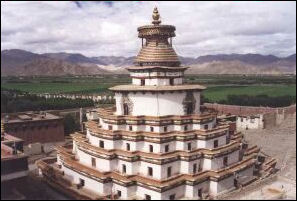
Gyantse Stupa in Tibet Buddhist Art:
Buddhist Symbols viewonbuddhism.org/general_symbols_buddhism ; Wikipedia article on Buddhist Art Wikipedia ;
Asian Art at the British Museum britishmuseum.org;
Buddhism and Buddhist Art at the Metropolitan Museum of Art metmuseum.org ;
Buddhist Art Huntington Archives Buddhist Art dsal.uchicago.edu/huntington ; Buddhist Art Resources academicinfo.net/buddhismart ; Buddhist Art, Smithsonian freersackler.si.edu ; Asia Society Museum asiasocietymuseum.org
Websites and Resources on Buddhism: Buddha Net buddhanet.net/e-learning/basic-guide ; Internet Sacred Texts Archive sacred-texts.com/bud/index ; Introduction to Buddhism webspace.ship.edu/cgboer/buddhaintro ; Early Buddhist texts, translations, and parallels, SuttaCentral suttacentral.net ; East Asian Buddhist Studies: A Reference Guide, UCLA web.archive.org ; View on Buddhism viewonbuddhism.org ; Tricycle: The Buddhist Review tricycle.org ; BBC - Religion: Buddhism bbc.co.uk/religion
RECOMMENDED BOOKS:
“Buddhist Architecture” by Le Huu Phuoc Amazon.com ;
“Buddhist Art and Architecture” by Robert E. Fisher Amazon.com ;
“Borobudur: Golden Tales of the Buddhas” by John N. Miksic, Anita Tranchini, et al. Amazon.com ;
“Borobudur: Majestic Mysterious Magnificent” by John N. Miksic, Amazon.com ;
“How to Read Buddhist Art” (The Metropolitan Museum of Art - How to Read)
by Kurt A. Behrendt Amazon.com ;
“Reading Buddhist Art: An Illustrated Guide to Buddhist Signs and Symbols” by Meher McArthur Amazon.com ;
“The Encyclopedia of Tibetan Symbols and Motifs” by Robert Beer Amazon.com;
“The Tibetan Iconography of Buddhas, Bodhisattvas, and Other Deities: A Unique Pantheon” by Lokash Chandra and Fredrick W. Bunce Amazon.com
“Buddhist Art: An Historical and Cultural Journey” by Giles Beguin Amazon.com ;
“Tree & Serpent: Early Buddhist Art in India” by John Guy Amazon.com ;
“Early Buddhist Narrative Art: Illustrations of the Life of the Buddha from Central Asia to China, Korea and Japan” by Patricia E. Karetzky Amazon.com;
“Pilgrimage and Buddhist Art” by Adriana Proser, Susan Beningson Amazon.com ;
“The Buddhist Art of China” by Zhang Zong Amazon.com;
“Cave Temples of Dunhuang: Buddhist Art on China’s Silk Road”
by Neville Agnew, Marcia Reed, et al.
Amazon.com;
“Cave Temples of Mogao at Dunhuang: Art and History on the Silk Road”
by Roderick Whitfield, Susan Whitfield, et al Amazon.com;
Buddhist Structures and Buildings
There are essentially three kinds of Buddhist structures: 1) stupas, bell-shaped structures that contain a holy relic or scripture; 2) temples, place of worship somewhat similar to a church; and 3) monasteries, which contain living quarters and meditation cells for monks.
Buddhist temples generally have statues of the Buddha or bodhisattvas (Buddha-like, semi-deities). These are sometimes used as aids to meditation. In China and Japan, some Buddhist temples are called pagodas and are built several stories high, with a curved roof and a tower on top. Some Buddhist temples are built to symbolize the five elements: water, air, fire, earth, and wisdom. The base of such temples is square, symbolizing the earth, and comes to a point at the top, representing wisdom. [Source: Encyclopedia.com]
Stupas are solid structures that typically cannot be entered and were constructed to contain sacred Buddhist relics that are hidden from view (and vandals) in containers buried at their core or in the walls. Temples have an open interior that may be entered and in which are displayed one or more cult images as a focus for worship. Although this simple distinction between Stupa and temple is useful, the distinction is not always clear. There are stupas that have the external form of a stupa but are like a temple with an inner corridor and multiple shrines.
See Separate Article THERAVADA BUDDHIST TEMPLES (WATS), ARCHITECTURE AND TEMPLE RITUALS factsanddetails.com ; TIBETAN ARCHITECTURE: TEMPLES, PALACES, STUPAS factsanddetails.com BURMESE ARCHITECTURE factsanddetails.com ANGKOR WAT factsanddetails.com Also see articles on temples under religion in Tibet, Japan, and China and articles on Monasteries and Monastery Architecture
History of Buddhist Architecture

Mahabodhi Temple Complex in Bodhgaya, where Buddha experienced his enlightenment
Some of the earliest examples of Buddhist art and architecture are the great stupas of Sanchi Bharhut, and Amaravati. These stupas contained relics of the Buddha and were decorated spectacular stone reliefs. Serving not only as ornamentation, these sculptures aimed to visually convey the Buddha's teachings and people about the dharma. Important episodes from the Buddha's life are depicted such as his defeat of the evil Mara before enlightenment and the rice gruel offered by Sujata before he began his enlightenment meditation. [Source: Jacob Kinnard, Worldmark Encyclopedia of Religious Practices, 2018, Encyclopedia.com]
The word for temple in many languages is the same as cave. Many early Buddhist temples were "artificial caves" that attempted to recreate the atmosphere of Buddhist caves in northern India. Describing what they were probably like, the historian Paul Strachen wrote: In his book “Pagan: Art and Architecture of Old Burma” , "the now spartan brick “gu” [temple]" was "cluttered with regal objects and requisites, a clamor of activity as food offerings were shuttled from the kitchens down passageways crowded with chanting devotees, brightly colored wall paintings, gilded furnishings and flapping banners and hangings...the usual plain, seated Buddha image, found in the deserted temples of Pagan today, would have been bathed, perfumed and dresses with the finest and most costly garments."
The architecture of Buddhist temples is influenced by the architecture of country in which they are found and various traditions of Buddhist architecture. Japanese pagodas, for example, have unique Japanese features that are modeled after Chinese-style pagodas, which in turn were modeled after Indian stupas.
Because ancient wood temples were often destroyed by fire, temples today are usually made of brick and stone with brass and iron ornaments. Chinese pagodas were often built to commemorate important leaders or event or house important artifacts or documents.
Stupas
Stupas are generally solid, bell-shaped structures that contain a holy relic such as a hair or tooth from Buddha, relics or remains of eminent Buddhist figure, or a sacred Buddhist scripture. They are modeled on ancient Indian burial mounds. The base of the stupa is often sealed with a copper plate incised with a “vishva-vajra” crossed thunderbolt design that is regarded as protection from evil. Stupas themselves were venerated as symbols of the Buddha.

Dhamekh stupa in Sarnath, where Buddha gave his first sermon
Buddhist stupas symbolize the Buddhist concept of the universe. The solid dome that rises up from the square or circular base is a representation of the dome-shaped sky enclosing the world-mountain, which pierce the dome to form a small balcony at the summit. At the center of the dome is a mast that represents that axis of the earth which rise from the waters that surround the world up to the cosmos. Square bases often also symbolize the earth. The shape of stupas may have been inspired by the staff and begging bowl of the wandering Buddha.
All stupas contain a treasury filled with various objects. Many contain jewelry and other “precious” objects. It is not necessary that the jewelry be expensive. What is important is the symbolic value that is important, not the value in monetray terms. It is believed that the more objects placed into the stupa, the stronger the energy of the Stupa will be. Stupas generally have a Tree of Life, a wooden pole covered with gems and thousands of mantras. It is placed in the central channel of the stupa during a ceremony or initiation, with participants holding colorful ribbons connected to the Tree of Life. These participants pray hard and send their most positive and powerful wishes and blessings, which are stored in the Tree of Life.
Though once simple in form, stupas have become larger over the centuries, with some, such as the Shwedagon stupa in Rangoon, Myanmar, reaching 30 meters (one hundred feet) in height. Many also are now decorated with beautiful carvings and gold. Outside the stupas the faithful either meditate on the teachings of the master buried there or walk around the structure three times to remind themselves of the three major elements of Buddhism: the Buddha, the dharma, and the sangha.
History of Stupas
After Buddha’s death his relics were divided and a number of stupas were built to house them. Although no ancient stupas remain the relics they housed are believed to have been saved and placed in other stupas. Many of the oldest stupas date back to the period of Buddhist expansions during the rule of King Ashoka (268-239 B.C.) The objects inside stupas are often unknown. A gold reliquary excavated from a 2nd century B.C. stupa in Bimaran Afghanistan was decorated with images of Buddha and Hindu gods. The reliquary is believed to have contained the ashes of a revered saint or some object he touched.
Stupa developed in India in the 3rd century B.C. and were general objects of worship for Buddhists before the formation of Buddha imagery, sculpture and painting. Sanchi stupa, built near present-day Bhopal, India, is the oldest. It is shaped like a half sphere and built to allow worship around it. The functions of Buddhist stupas were also diffused, and shapes show a variety of styles in each cultural area. [Source: Takashi Sakai, Nihon Kôkogaku, May 20, 2008]
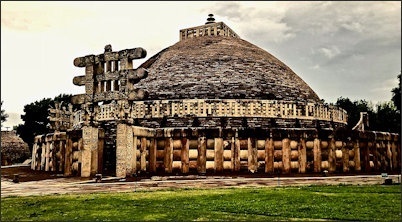
Great Stupa in Sanchi
Stupa is a Sanskrit word that literally means “to heap” or “to pile up.” Some scholars believe that stupas predated Buddhism and originally were mounds of dirt or rocks built to honor dead kings. Later, these scholars say, the Buddha imbued them with spiritual meaning. Sylvia Somerville wrote in her book on stupas: “This explanation runs counter to Buddhist tradition, which maintains that because the stupa conveys enlightened qualities, it could only have been revealed by the mind of enlightenment. …In fact, some stupas, such as the Swayambhunath Stupa in Nepal, are believed to be self-arising expressions of enlightenment.” [Source: “Stupas: Symbols of Enlightened Mind” by Sylvia Somerville]
Stupas are the oldest Buddhist religious monuments. The first Buddhist ones were simple mounds of mud or clay built to enclose relics of Buddha. In the third century B.C., after his conversion to Buddhism, Emperor Asoka ordered the original stupas opened and the remains were distributed among the several thousand stupas he had built. Stupas at the eight places associated with the life of the Buddha were important before Ashoka and continued to after his death. Over time, stupas changed from being funerary monuments to being objects of veneration. As this occurred they also changed in appearance changed also. [Source: Wikipedia +]
Over the centuries many old stupas became pilgrimage sites. Famous ones became the center of complex ceremonial areas. They were often surrounded by a railing with gateways, through which pilgrims entered the ceremonial ground. Stone lions guarded the entrances. Outside vendors sold food and offerings to pilgrims.
Sanchi: Home of the World’s Oldest Stupa
Sanchi (30 miles from Bhopal) is a pilgrimage site that attracts worshipers from all over the world who come to see Buddhist art and architecture that dates back to the third century B.C. Designated a UNESCO World Heritage Site in 1989 and regarded as one of the most remarkable archaeological complexes in India, it contains monasteries and the world’s oldest stupa.
According to UNESCO: “On a hill overlooking the plain and about 40 km from Bhopal, the site of Sanchi comprises a group of Buddhist monuments (monolithic pillars, palaces, temples and monasteries) all in different states of conservation most of which date back to the 2nd and 1st centuries B.C. It is the oldest Buddhist sanctuary in existence and was a major Buddhist centre in India until the 12th century A.D. [Source: UNESCO World Heritage Site website]
“ From the time that the oldest preserved monument on the site (Asoka's column with its projecting capital of lions inspired by Achaemenid art) was erected, Sanchi's role as intermediary for the spread of cultures and their peripheral arts throughout the Maurya Empire, and later in India of the Sunga, Shatavahana, Kushan and Gupta dynasties, was confirmed.

“Sanchi is the oldest extant Buddhist sanctuary. Although Buddha never visited the site during any of his former lives or during his earthly existence, the religious nature of this shrine is obvious. The chamber of relics of Stupa 1 contained the remains of Shariputra, a disciple of Shakyamuni who died six months before his master; he is especially venerated by the occupants of the 'small vehicle' or Hinayana. Having remained a principal centre of Buddhism in medieval India following the spread of Hinduism, Sanchi bears unique witness as a major Buddhist sanctuary to the period from the 3rd century BC to the 1st century AD.”
The ruins of about 50 monuments have been uncovered, “It would appear that the site was settled in the 3rd century BC at the time that the Emperor Asoka, the grandson of Chandragupta, who had defeated the Macedonian invaders and founded the Maurya dynasty, was converted to Buddhism (c. 250 BC). Asoka, whose queen was from the neighbouring town of Vidisha, founded, or at least embellished, a Buddhist sanctuary located at Sanchi. He also had a stone column more than 12 m high erected with his edicts carved on it.
“To the south of Asoka's column and predating it is an early brick stupa about 20 m in diameter and crowned with stone aedicula; a wooden railing encircles it. Now known as Stupa 1, this monument was enlarged under the Sunga and the Andhra dynasties (2nd and 1st centuries BC) and is the principal monument at Sanchi. It consists of a gigantic mound of sandstone surrounded by sumptuous porticoes with stone railings; its hemispherical dome measures 36.6 m in diameter and is 16.46 m high. It is particularly famous for the extraordinarily rich decorative work on the four monumental gateways (torana) that provide access. Positioned almost exactly in line with the four cardinal points, these gateways transpose into stone the structure of the wooden gateways: two pillars and three architraves reproduce the assembly of two posts joined by three rails.
“The lush carvings, prodigious creations in bas relief, high relief and in the round, are an iconographic treasure trove. The essential theme represented in the decorative work revolves around the former lives of Buddha. Numerous other themes were taken from legends and history. The fresh, wonderfully charming representations of plants, animals and humans, the narrative quality of the stories and the creativity apparent in the fantastic sculptured capitals and cornices combine to make this an unrivalled masterpiece of early Buddhist art. Sanchi has two other famous stupas dating from the Sunga period (2nd century BC). The torana of Stupa 3, executed in the 1st century, are exceptional works. Many other structures are found on the site: within the ruins of a wall dating from the 11th-12th centuries, Sanchi's final years are represented by monolithic pillars, palaces, temples and monasteries, all in varying states of preservation. Temples 17 and 45 and monastery 51 are among the most impressive structures.”
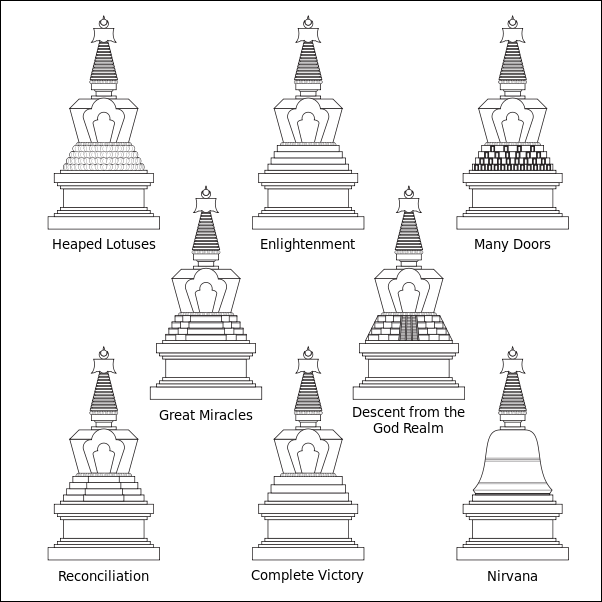
Eight Great Stupas
Buddhist Temples
A temple is a place of worship as opposed to a shrine, which is a sacred place for praying. It generally contains an image of Buddha and has a place where Buddhists practice devotional activities. Temples attract large crowds during festivals or if they are famous but otherwise a fairly quiet. They are often sought as places for quiet meditation, with most acts of worship and devotion being done in front of an altar at home.
Buddhist temples are generally a cluster of buildings — whose number and size depends on the size of the temple — situated in an enclosed area. Large temples have several halls, where people can pray, and living quarters for monks. Smaller ones have a single hall, a house fore a resident monk and a bell. Some have cemeteries.
Temples can be several stories high and often have steeply sloped roofs are often supported by elaborately-decorated and colorfully-painted eaves and brackets. The main shrines often contain a Buddha statue, boxes of sacred scriptures, alters with lit candles, burning incense and other offerings as well as images of Buddhas, Bodhisattvas and devas. The central images depends on the sect.
Buddhist temples come in many shapes and sizes. Pagodas found in China and Japan are perhaps the best known. Stupas, stone structure built over Buddhist scriptures or relics of the Buddha or famous holy men, are found throughout the Buddhist world. . Buddhist temples are designed to symbolise the five elements: 1) Fire, 2) Air, 3) Earth, symbolised by the square base, 4) Water, and 5)Wisdom, symbolised by the pinnacle at the top of the temple. All Buddhist temples contain an image or a statue of Buddha. [Source: BBC]
See Separate Article: BUDDHIST TEMPLES: TYPES, FEATURES AND ACTIVITIES factsanddetails.com
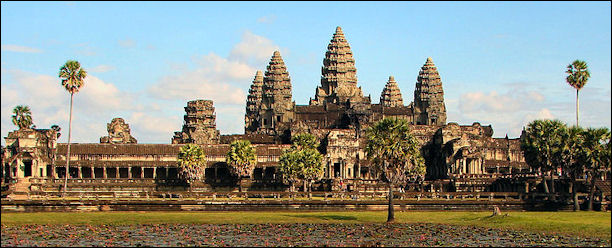
Angkor Wat, a Hindu-Buddhist temple
Buddhist temples usually contain numerous Buddha statues. The central Buddha images are often surrounded by burning incense sticks and offerings of fruit and flowers. Some contain the ashes or bone reliquaries of popular holy man. Many Buddhist temples face south and sometimes to the east, but never to the north and west which are regarded as unlucky directions according to Chinese feng shui. Many temples are entered through the left door and exited through the right.
The main hall is usually found at the center of the temple grounds. Inside are images of the Buddha, other Buddhist images, altars and space for monks and worshipers. The main hall is sometimes connected to a lecture hall, where monks gather to study and chant sutras.. Other buildings include a the sutra depositor, a library or place where Buddhist scripture are kept; living, sleeping, and eating areas for monks, and offices. Large temples often have special halls, where treasures are kept and displayed.
World's Oldest Buddhist Shrine Found in Nepal
In 2013, archaeologists said that a structure inside Mayadevi temple in Lumbini, Buddha’s birthplace, dated to the sixth century B.C. — when Buddha is believed to have been alive Associated Press reported: “Archaeologists in Nepal say they have discovered traces of a wooden structure dating from the sixth century B.C. which they believe is the world's oldest Buddhist shrine. Kosh Prasad Acharya, who worked with archaeologists from Durham University, said that the structure had been unearthed inside the sacred Mayadevi temple in Lumbini. The Buddha, also known as Siddhartha Gautama, is generally thought to have been born in about the sixth century BC at the temple site. The findings were published in the December issue of the journal Antiquity. [Source: Associated Press, November 26, 2013 )~(]
“Acharya said the traces had been date tested using radiocarbon and luminescence techniques. The archaeological team dug underneath previously known brick structures in the temple, and experts from the University of Stirling examined and collected the samples, he said. The team has been working at the site for the past three years. The site at Lumbini had been hidden under the jungle until it was excavated in 1896. )~(
See World's Oldest Buddhist Shrine — Dating to the Buddha’s Time — Found in Lumbini Under BUDDHISM'S HOLIEST SITES factsanddetails.com
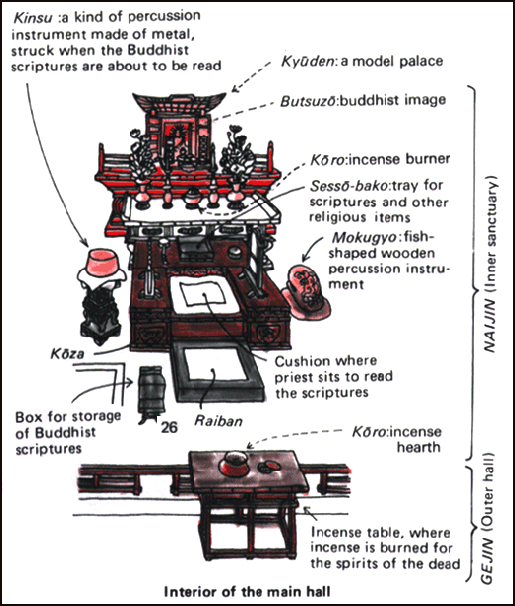
Buddhist Temple in Pakistan — One of the World’s Oldest
In 2022, archaeology announced that they had found one of the world’s oldest known Buddhist temples atop the ancient acropolis of Barikot in the Swat Valley of present-day Pakistan. The complex, which is preserved to a height of over three meters (more than 10 feet), dates to the 2nd century B.C. It was built on a platform and features a cylindrical structure, a small stupa, and a number of small rooms. The site has a more than 3,000-year-long history and was purportedly besieged by Alexander the Great in 327 B.C. [Source: Archaeology magazine, May 2022]
Jarrett A. Lobell wrote in Archaeology Magazine: The region of northwest Pakistan known as the Greater Gandhara was a crossroads for the exchange of goods and culture among the civilizations of the Middle East, Central Asia, and India from around the sixth century B.C. to the sixth century A.D. One of the most significant belief systems carried across the region was Buddhism, which was founded in northern India between the late sixth and early fourth centuries B.C. [Source: Jarrett A. Lobell, Archaeology Magazine, January/February 2023]
See Buddhist Temple in Pakistan — One of the World’s Oldest Under GANDHARA: ITS GREAT BUDDHIST ART AND TAXILA factsanddetails.com
Image Sources: Wikicommons Media, Japanese National Tourist Organization
Text Sources: Metropolitan Museum of Art, Asia for Educators, Columbia University; Asia Society Museum “World Religions” edited by Geoffrey Parrinder (Facts on File Publications, New York); “Encyclopedia of the World's Religions” edited by R.C. Zaehner (Barnes & Noble Books, 1959); BBC, Wikipedia, National Geographic, New York Times, Washington Post, Los Angeles Times, Smithsonian magazine, The New Yorker, Reuters, AP, AFP, and various books and other publications.
Last updated March 2024
